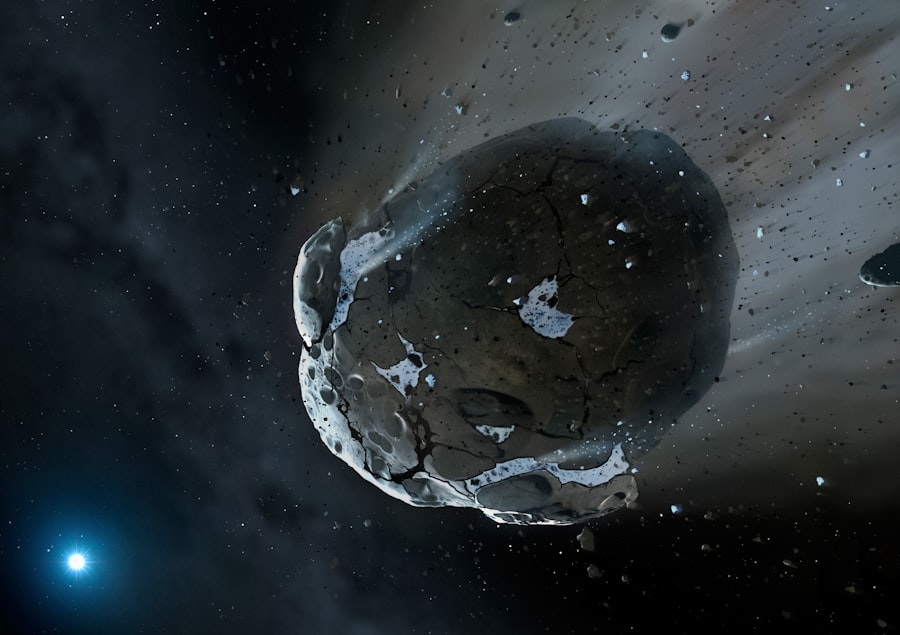White dwarfs are the remnants of stars that have exhausted their nuclear fuel, marking a significant phase in stellar evolution. The origins of these celestial objects can be traced back to stars with initial masses between approximately 0.08 and 8 solar masses. When such stars reach the end of their life cycles, they undergo a series of transformations that ultimately lead to the formation of a white dwarf.
The process begins with hydrogen fusion in the star’s core, which generates energy and counteracts gravitational collapse. As the hydrogen is depleted, the core contracts and heats up, leading to the fusion of helium into heavier elements. As the star evolves, it enters the red giant phase, during which it expands significantly.
In this phase, the outer layers are expelled into space, creating a planetary nebula, while the core remains intact. This core, composed primarily of carbon and oxygen, is what we recognize as a white dwarf. The ejected material contributes to the interstellar medium, enriching it with heavy elements formed during the star’s life.
The transition from a red giant to a white dwarf is a critical moment in stellar evolution, as it marks the end of nuclear fusion processes within the star and sets the stage for its eventual cooling and dimming over billions of years.
Key Takeaways
- White dwarfs are the remnants of medium-sized stars that have exhausted their nuclear fuel.
- They possess high density, strong gravity, and emit light primarily from residual heat.
- White dwarfs represent the final evolutionary stage for many stars before cooling into black dwarfs.
- Their unique properties challenge existing astrophysical theories and reveal complex internal processes.
- Studying white dwarfs provides insights into planetary system evolution and the future of our own solar system.
Characteristics and Properties of White Dwarfs
White dwarfs are characterized by their high density and relatively small size. Typically, they have masses comparable to that of the Sun but are confined within a volume similar to that of Earth. This extraordinary density means that a sugar-cube-sized amount of white dwarf material would weigh about a ton on Earth.
In terms of temperature, white dwarfs are initially very hot, with surface temperatures exceeding 100,000 Kelvin shortly after their formation. However, they gradually cool over time, transitioning from blue-white to red as they age.
Their luminosity decreases significantly as well, making them increasingly difficult to detect with time. The spectral characteristics of white dwarfs often reveal their chemical composition; many exhibit traces of hydrogen or helium in their atmospheres, while others may show evidence of heavier elements like carbon or oxygen. This diversity in composition provides insights into their progenitor stars and the processes that occurred during their evolution.
The Life Cycle of White Dwarfs

The life cycle of a white dwarf begins after it has shed its outer layers and ceased nuclear fusion. Once formed, a white dwarf enters a long phase of cooling and dimming that can last billions of years. Initially, these stars are incredibly hot and luminous, but as they radiate energy into space, they gradually lose heat.
The cooling process is governed by several factors, including mass and composition; more massive white dwarfs tend to cool more slowly due to their greater gravitational binding energy. Over time, white dwarfs will eventually reach a state known as “black dwarf,” although this stage is theoretical since the universe is not old enough for any black dwarfs to exist yet. A black dwarf would be a cold, dark remnant that no longer emits significant heat or light.
The transition from white dwarf to black dwarf is an incredibly slow process; estimates suggest it could take trillions of years for a white dwarf to cool sufficiently to become a black dwarf. This extended timeline highlights the stability of white dwarfs in the cosmic landscape and their role as long-lived remnants of stellar evolution.
The Enigmatic Nature of White Dwarfs
Despite being well-studied objects in astrophysics, white dwarfs still hold many mysteries that intrigue researchers. One such enigma is the presence of crystallization in their interiors. As white dwarfs cool, their cores can crystallize into solid structures composed primarily of carbon and oxygen.
This process releases latent heat, which can slow down cooling rates unexpectedly. Understanding this crystallization process is crucial for accurately modeling the cooling sequences of white dwarfs and determining their ages. Another area of intrigue involves the magnetic fields associated with some white dwarfs.
A subset of these stars exhibits strong magnetic fields that can influence their behavior and emissions. The origin of these magnetic fields remains an open question; they may arise from dynamo processes during stellar evolution or from interactions with companion stars in binary systems. The study of magnetic white dwarfs not only sheds light on their unique properties but also provides insights into the broader mechanisms governing stellar magnetism.
White Dwarfs in Relation to Planetary Systems
| Metric | Value | Unit | Description |
|---|---|---|---|
| Mass | 0.6 | Solar masses | Average mass of a typical white dwarf |
| Radius | 0.01 | Solar radii | Approximate radius, about Earth-sized |
| Density | 1 x 106 to 1 x 109 | g/cm³ | Typical density range of white dwarfs |
| Surface Temperature | 5,000 to 100,000 | K | Range of surface temperatures observed |
| Composition | Carbon and Oxygen | – | Most common core elements |
| Chandrasekhar Limit | 1.4 | Solar masses | Maximum mass before collapse |
| Luminosity | 0.0001 to 0.01 | Solar luminosities | Typical luminosity range |
The relationship between white dwarfs and planetary systems is a fascinating aspect of their study. As stars evolve into white dwarfs, they often disrupt any surrounding planetary systems during their red giant phase. However, remnants of these systems can persist even after the star has transformed into a white dwarf.
Observations have revealed that some white dwarfs exhibit signs of planetary debris in their atmospheres, suggesting that they have accreted material from nearby asteroids or planets. The presence of heavy elements like magnesium, iron, and calcium in the atmospheres of certain white dwarfs indicates that these stars have ingested rocky material from their former planetary systems. This accretion process provides valuable information about the composition and dynamics of planetary systems around evolved stars.
Furthermore, studying these interactions can help astronomers understand the fate of planets in systems where stars evolve into red giants and subsequently become white dwarfs.
Observing and Studying White Dwarfs

Observing white dwarfs presents unique challenges due to their faintness and small size compared to other celestial objects. However, advancements in telescope technology and observational techniques have significantly enhanced our ability to study these stars. Space-based observatories like the Hubble Space Telescope and the upcoming James Webb Space Telescope are particularly well-suited for observing white dwarfs due to their ability to capture high-resolution images and spectra without atmospheric interference.
Spectroscopy plays a crucial role in studying white dwarfs by allowing astronomers to analyze their light spectra for chemical signatures. By examining absorption lines in these spectra, researchers can determine the composition, temperature, and even magnetic fields of white dwarfs. Additionally, photometric observations help track changes in brightness over time, providing insights into cooling rates and potential interactions with companion objects.
The Future of White Dwarf Research
The future of white dwarf research is poised for exciting developments as new technologies and methodologies emerge. Upcoming astronomical surveys and missions aim to catalog large numbers of white dwarfs across various environments, enhancing our understanding of their distribution and characteristics within different galactic contexts. For instance, projects like Gaia are already providing unprecedented data on stellar populations, including white dwarfs, allowing for detailed studies on their formation histories and evolutionary pathways.
Moreover, advancements in computational modeling will enable researchers to simulate the complex processes governing white dwarf evolution more accurately. These models will incorporate factors such as crystallization effects, magnetic fields, and interactions with companion stars or planetary systems. As our understanding deepens, we may uncover new phenomena associated with white dwarfs that challenge existing theories and expand our knowledge of stellar evolution.
Implications of White Dwarf Discoveries
The discoveries surrounding white dwarfs have far-reaching implications for our understanding of astrophysics and cosmology. For one, studying these remnants provides critical insights into the life cycles of stars and the processes that govern stellar evolution across different mass ranges. White dwarfs serve as cosmic laboratories for testing theories related to nuclear physics, quantum mechanics, and thermodynamics under extreme conditions.
Additionally, the study of white dwarfs contributes to our understanding of dark matter and dark energy through their role in galactic dynamics and evolution. By analyzing populations of white dwarfs in various galaxies, astronomers can glean information about the mass distribution within those galaxies and how it influences their overall structure and behavior over cosmic timescales. Furthermore, as we explore the remnants of planetary systems around white dwarfs, we gain insights into the potential habitability of exoplanets in similar environments.
Understanding how planets interact with evolved stars can inform our search for life beyond Earth by highlighting conditions that may support or hinder habitability in distant worlds. In summary, white dwarfs are not merely stellar remnants; they are key players in the cosmic narrative that shapes our universe’s structure and evolution. Their study continues to unveil new mysteries while reinforcing fundamental principles in astrophysics, making them an enduring focus for researchers seeking to unravel the complexities of our cosmos.
White dwarfs are fascinating remnants of stars that have exhausted their nuclear fuel, and they play a crucial role in our understanding of stellar evolution.
You can read more about it in this article: The Nature and Value of Knowledge.





















+ There are no comments
Add yours